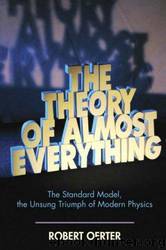The Theory of Almost Everything: The Standard Model, the Unsung Triumph of Modern Physics by Robert Oerter

Author:Robert Oerter
Language: eng
Format: azw3, mobi, epub
Tags: Science
ISBN: 9780132366786
Publisher: Pi Press
Published: 2006-08-15T03:21:13+00:00
The Strong, the Weak, and the Strange
By 1950, physicists had come to realize that they needed yet another classification to deal with the nuclear forces. On the one hand, there was the muon. It clearly had something to do with nuclear forces since it was produced when a nucleus suffered beta decay. However, this interaction was seemingly very weak: this was the conclusion of the famous Italian experiment discussed in the previous chapter, which showed that muons were absorbed very slowly in matter. Whatever force was involved in these muon processes must be a very weak one. On the other hand, there was the pion, which was absorbed very rapidly in matter in a manner completely consistent with Yukawa’s predictions. The force carried by pions must be extremely strong, as it must hold the protons together in the nucleus while their electromagnetic repulsion is trying to tear them apart. Physicists began to speak of two different nuclear forces, called (prosaically but practically) the strong force and the weak force.
Confirmation of the strong/weak distinction came from the newly discovered subatomic particles. Some of these had extremely short lifetimes, around 10-24 second; comparable to the lifetime we calculated earlier for virtual pions. This was a good indication that the force involved with the decay of these particles was the same as the force involved with the pions. Other particles, the muon, for instance, had lifetimes of a few microseconds. This is very short in everyday terms, but many trillions of times longer than the lifetimes associated with the strong force. According to the Heisenberg uncertainty principle, ΔE Δt ≥ ℏ, a short lifetime corresponds to a large energy difference, and hence a large force; whereas a longer lifetime corresponds to a smaller energy and smaller force. So it makes sense that the strongly interacting particles should have shorter lifetimes and the weakly interacting particles should have longer lifetimes.
Some particles, like the muon, never participate in strong interactions. Other particles participate in both the strong and the weak interactions. Take the pion, for example. It certainly figures in the strong force: it’s the glue that holds the nucleus together. Its lifetime, however, is around 10-8 second—much too long to be explained by the strong force. In fact, when it decays it produces a muon and an antineutrino, both of which are particles that interact only via the weak (or electromagnetic) force, never the strong force. There must be some reason that the pion, a strongly interacting particle, can only decay by the weak force. This explains both its relatively long lifetime and the particles that result from the decay. A deeper understanding of the nature of the pion had to await the development of the Standard Model.
One more classification we need to know about was invented for the strange new particles that left V-shaped tracks in the cloud chambers. Like the pion, their lifetimes were too long—around 10-10 second, rather than the 10-24 second expected from the strong interaction. But the solution found for the pion wouldn’t work for the new particles.
Download
The Theory of Almost Everything: The Standard Model, the Unsung Triumph of Modern Physics by Robert Oerter.mobi
The Theory of Almost Everything: The Standard Model, the Unsung Triumph of Modern Physics by Robert Oerter.epub
This site does not store any files on its server. We only index and link to content provided by other sites. Please contact the content providers to delete copyright contents if any and email us, we'll remove relevant links or contents immediately.
The Complete Stick Figure Physics Tutorials by Allen Sarah(7307)
Secrets of Antigravity Propulsion: Tesla, UFOs, and Classified Aerospace Technology by Ph.D. Paul A. Laviolette(5309)
Thing Explainer by Randall Munroe(3877)
The River of Consciousness by Oliver Sacks(3538)
The Order of Time by Carlo Rovelli(3145)
How To by Randall Munroe(3033)
A Brief History of Time by Stephen Hawking(2960)
I Live in the Future & Here's How It Works by Nick Bilton(2935)
The Great Unknown by Marcus du Sautoy(2646)
What If?: Serious Scientific Answers to Absurd Hypothetical Questions by Randall Munroe(2637)
Midnight in Chernobyl by Adam Higginbotham(2483)
Blockchain: Ultimate Step By Step Guide To Understanding Blockchain Technology, Bitcoin Creation, and the future of Money (Novice to Expert) by Keizer Söze(2445)
Networks: An Introduction by Newman Mark(2360)
The Meaning of it All by Richard Feynman(2300)
Easy Electronics by Charles Platt(2281)
The Tao of Physics by Fritjof Capra(2229)
Midnight in Chernobyl: The Untold Story of the World's Greatest Nuclear Disaster by Adam Higginbotham(2177)
When by Daniel H Pink(2082)
Introducing Relativity by Bruce Bassett(2076)
